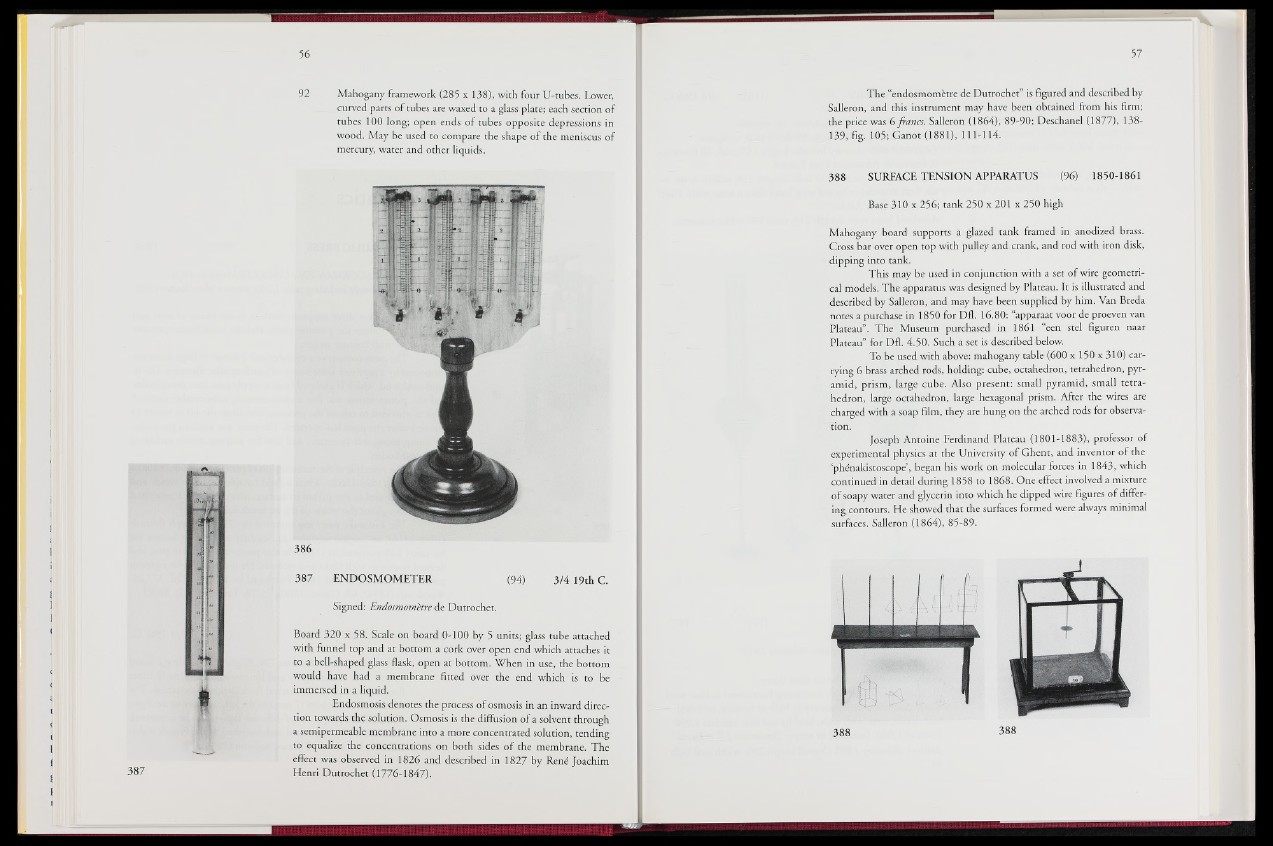
92 Mahogany framework (285 x 138), with four U-tubes. Lower,
curved parts of tubes are waxed'to a glass plate; each section of
tubes 100 long; open ends of tubes opposite depressions in
wood. May be used to compare the shape of the meniscus of
mercury, water and other liquids.
387 ENDOSMOMETER (94) 3/4 19th C.
Signed: Endosmometre de Dutrochet.
Board 320 x 58. Scale on board 0-100 by 5 units; glass tube attached
with funnel top and at bottom a cork over open end which attaches in
to a ibfUrshaped glass flask, open at bottom. When in use, the bottom
would have had a membrane fitted over the end which is to be
immersed in a liquid.
Endosmosis denotes the process of osmosis in an inward direction
towards the solution. Osmosis is the diffusion of a solvent through
a semipermeable membrane into a more concentrated solution, tending
to equalize the concentrations on both sides of the membrane. The
effect was observed in 1826 and described in 1827 by René Joachim
Henri Dutrochet (ll||6-1847).
The “endosmomètre de DutrochetMs figured and described by
Salleron, and this instrument may have been obtained from his firm;
the price was 6 francs. Salleron (1864), 89-90; Deschanel (1877), 138-
139, fig. 105; Ganot (1881), 111-114.
388 SURFACE TENSION APPARATUS • (96) 1850-1861
Base 310 x 256; tank 250 x 201 x 250 high
Mahogany board supports a glazed tank framed in anodized brass.
Cross bar over open top with pulley and crank, and rod with iron disk,
dipping into tank.
This may be used in conjunction with a set of wire geometrical
models. The apparatus was designed by Plateau. It is illustrated and
described by Salleron, and may have been supplied by him. Van Breda
notes a purchase in 1850 for D j|l6 .8 0 : ‘apparaat voor de proeven van
Plateau”. The Museum purchased i®fe 1861 “een stel figuren naar
Plateau” for Dfl. 4,50. Such a set is described below.
To be used with above: mahogany table (600 x 150 x 310) carrying
6 brass arched rods, holding: cube, octahedron, tetrahedron, pyramid,
prism, large cube. Also present: small pyramid, small tetrahedron,
large octahedron, large hexagonal prism. After the wires are
charged with a soap film, they are hung on the arched rods for observation.
Joseph Antoine Ferdinand Plateau (1801-1883), professor of
experimental physics at the University of Ghent, and inventor of the
phénakistoscope’, began his work on molecular forces in 1843, which
continued in detail during 1858 to 1868. One effect involved a mixture
of soapy water and glycerin into which he dipped wire figures of differing
contours. He showed that the surfaces formed were always minimal
surfaces. SalleronB.864), 85-89.
388 388